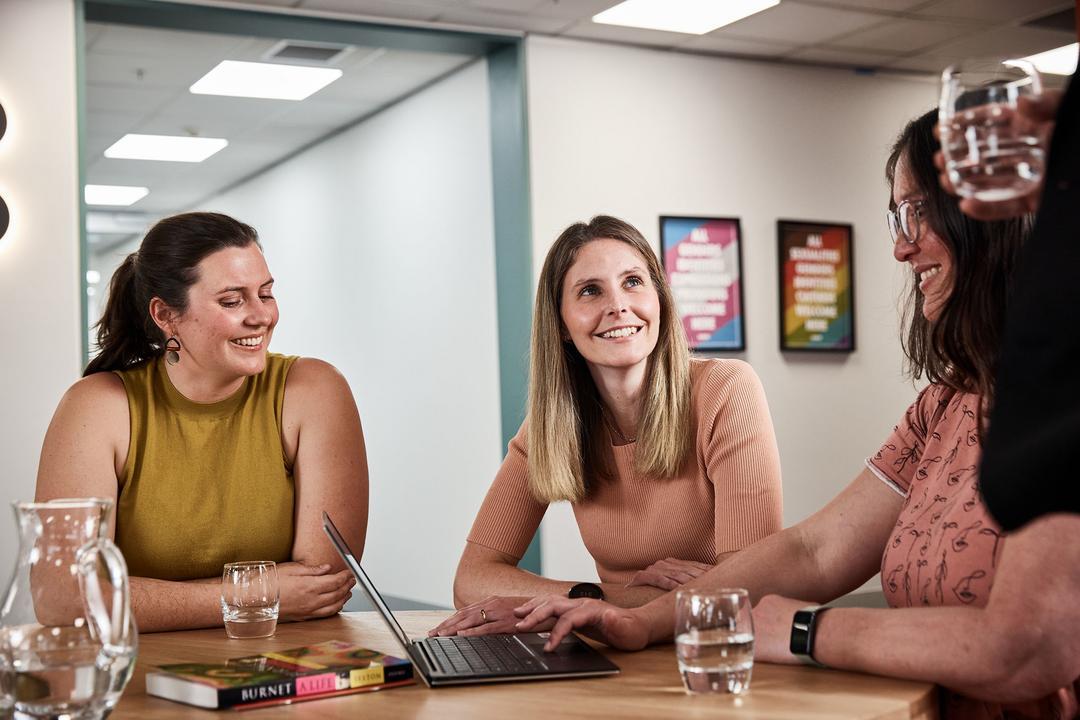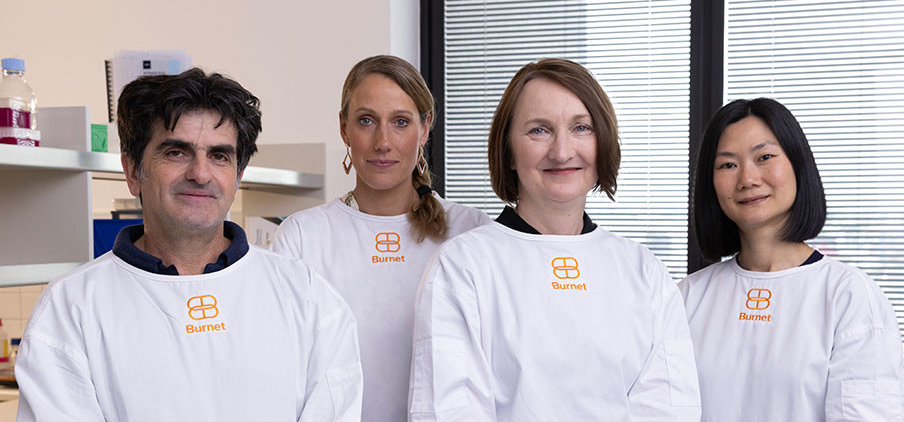
The Optimise Study: Optimising Isolation, Quarantine and Distancing for COVID-19
The Optimise Study is a research project led by Burnet Institute and Doherty Institute that aims to find out how Victorians are experiencing COVID-19 and responding to the measures introduced to stop the spread of the virus.
Objective
The information gathered in this research project will help guide Victoria’s approach to COVID-19, both to prevent new infections and to reduce the health, social and economic impacts of COVID-19 restriction and prevention measures. This network image is an example of close contact between people from the Optimise Project which covers from the beginning of the project in September 2020 until September 2021. The network image does not show all people involved in the Optimise Project, but instead focuses on only some of the connections between people.
The blue dots are people in the Optimise Project, and are participants or other people that participants have contact with. The grey lines represent the close contact between people. You can see that between some people (i.e., some blue dots) there are many lines between people who interact a lot with one another. Between other people, there is only one connection between people indicating only one interaction between those people. And of course, there are no lines between some people, meaning they do not have contact with one another at all.
You can see that some people cluster together in groups, while others only have regular contact with one other person. It is natural for people to differ in how many others they connect with. The Optimise Study is a research project led by Burnet Institute and Doherty Institute, that aims to find out how Victorians are experiencing COVID-19 and responding to the measures introduced to stop the spread of the virus.
Approach
Collect strategic information
This includes:
- understanding compliance and adherence with social isolation, quarantine and physical distancing
- determining key factors affecting cooperation with social and physical distancing measures, including health, social, structural and economic factors
- assessing unintended consequences of isolation and distancing measures on key vulnerable groups and among the general population
- identifying vulnerable populations for whom sustaining self-isolation is more difficult or who are disproportionately affected
- measuring social contacts and mixing patterns to inform transmission modelling and assess if key groups or individuals are at higher risk of COVID-19 infection.
Inform national policy and practice
This includes:
- informing government strategy to release the population from the current “lock down” in a precise and informed way, that mitigates the risk of a flare up of new infections
- improving messaging and to enhance comprehension, acceptability and cooperation with Government guidance and interventions
- testing the feasibility and acceptability of emerging strategies for COVID-19 testing such as point-of-care tests, home-based testing and antibody testing
- developing strategies to support highly vulnerable populations to reduce their risk of infection and limit unintended consequences
- reporting to the State and Federal Government through regular reports on compliance, key factors affecting compliance, and mechanisms to improve compliance.
Understand and predict through mathematical models
This includes:
- developing dynamic precision agent based mathematical models, utilising empirical data from the Optimise Study to inform and test strategic, such as the timing of the government’s release and restore strategies and the impact of various testing strategies,
Evidence from the Optimise Study will also assist community organisations and key health service groups in restoring economic activity and recreational activities whilst keeping new infections of COVID-19 at a low level. This involves real-time testing of key interventions to allow global scaling at speed.
Resources
-
The Optimise Study: Vaccine preparedness
This report explores responses from Optimise Study participants about their attitude towards COVID-19 vaccines, views on the rollout strategy and information needs.
Optimise Report 4 Mar 2021 [PDF 701.7 kB] -
The Optimise Study: Vaccine preparedness (PUBLIC HEALTH REPORT)
This report explores responses from Optimise Study participants about their attitude towards COVID-19 vaccines, views on the rollout strategy and information needs.
Optimise REPORT4 Final [PDF 698.4 kB] -
The Optimise Study: Social networks and mixing patterns
This report explores responses from Optimise Study participants about overall contacts, contacts over time, how contacts impact mood and how social networks influence vaccination attitudes.
Optimise REPORT5 April 5 2021 [PDF 2.2 MB]
-
The Optimise Study: Social networks and mixing patterns. (PUBLIC HEALTH REPORT)
This report explores responses from Optimise Study participants about overall contacts, contacts over time, how contacts impact mood and how social networks influence vaccination attitudes.
Optimise REPORT5 Final [PDF 2.2 MB] -
The Optimise Study: Gendered differences in coping and responding to COVID-19. (PUBLIC HEALTH REPORT)
This report surveys Optimise Study participants to explore gendered differences in managing and responding to COVID 19 across employment, mental health, lifestyle and risk perception.
Optimise REPORT6 Final [PDF 785.1 kB] -
The Optimise Study: The impact of COVID19 on income and finances (PUBLIC HEALTH REPORT)
This report explores responses from Optimise Study participants about COVID-19’s impact on employment status, work and career changes, financial hardship and access to financial support.
Optimise Report 7 Jun 2021 [PDF 752.5 kB] -
The Optimise Study: Impact of government restrictions on risk mitigation strategies. (PUBLIC HEALTH REPORT)
This report surveys Optimise Study participants about social contacts and social distancing, COVID-19 testing behaviours and trends, and the acceptability of government interventions.
Optimise REPORT8 Final [PDF 1.0 MB] -
The Optimise Study: Vaccination knowledge, attitudes and beliefs (PUBLIC HEALTH REPORT)
This report explores responses from Optimise Study participants about COVID-19 vaccinations including intentions to be vaccinated, motivating factors, concerns, knowledge, beliefs and expectations.
Optimise REPORT9 Final [PDF 903.6 kB] -
The Optimise Study: COVID-19 testing and vaccination (PUBLIC HEALTH REPORT)
This report collates the findings from Optimise COVID-19 research activities including participant responses, qualitative interviews and community meetings.
Optimise REPORT11 Final [PDF 817.4 kB] -
The Optimise Study: COVID-19 testing in schools and attitudes and concerns about the current state of the pandemic. (PUBLIC HEALTH REPORT)
This report summarises responses in the COVID-19 Optimise study regarding the frequency and method of testing among school students and thoughts on the pandemic.
Optimise Report 12 Nov 2021 [PDF 1.7 MB] -
The Optimise Study: Impacts of the COVID-19 response on culturally and linguistically diverse communities. (PUBLIC HEALTH REPORT)
This report explores responses from Optimise Study participants about access and adequacy of COVID-19 information, financial hardship, experiences of racism, and expectations post vaccination.
Optimise REPORT13 Final [PDF 992.4 kB] -
The Optimise Study: COVID-19 worry and perceptions about infection and potential severity. (PUBLiC HEALTH REPORT)
This report explores responses from Optimise Study participants about their main concerns regarding the COVID-19 pandemic, risk perception and confidence in government responses.
Optimise Report 14 Mar 2022 [PDF 762.9 kB] -
The Optimise Study: COVID-19 testing, test positivity and contacts over time. (PUBLIC HEALTH REPORT)
This report explores responses from Optimise Study participants about their COVID 19 testing patterns, test positivity and changing contacts over time.
Optimise REPORT15 Final [PDF 1.0 MB] -
The Optimise Study: COVID-19 related worry, acceptability of prevention measures and confidence in Government. (PUBLIC HEALTH REPORT)
This report explores responses from Optimise Study participants about their COVID 19-related concerns, views on prevention measures and confidence in government over time.
Optimise Report 16 [PDF 1.2 MB] -
The Optimise Study: COVID-19 vaccine intention, and adherence to isolation and quarantine recommendations. (PUBLIC HEALTH REPORT)
This report explores responses from Optimise Study participants about COVID-19 vaccine intentions, adherence to isolation and quarantine, and contacts before testing positive and entering isolation.
Optimise Report 17 [PDF 975.8 kB] -
The Optimise Study: A rapid survey examining concerns about children returning to school in 2022. (PUBLIC HEALTH REPORT)
This report explores responses from Optimise Study participants about schools re-opening during the COVID-19 pandemic, COVID-19 testing and prevention in schools and potential school closures.
Optimise Special Report Apr 2022 [PDF 927.0 kB] -
The Optimise Study: A rapid survey examining the influence of potential cessation of the Victorian pandemic declaration. (PUBLIC HEALTH REPORT)
This report explores responses from Optimise Study participants about their behaviours under the current COVID-19 pandemic declaration and potential behaviours should the declaration cease.
Optimise Special Report Jun 2022 [PDF 2.0 MB] -
The Optimise Study: A rapid survey examining frequency, impacts of long COVID and associated concerns. (PUBLIC HEALTH REPORT).
This report explores responses from Optimise Study participants about their experience of long COVID and any behaviours used to mitigate the risk of developing it.
Optimise Special Report Aug 2022 [PDF 1.3 MB] -
The Optimise Study: Summer 2021–2022 Snapshot. (PUBLIC HEALTH REPORT)
This report explores responses from Optimise Study participants about their COVID-19 experiences during the 2021–22 summer with a particular focus on the January 2022 peak.
Optimise_snapshot_summer_final.pdf [PDF 3.8 MB]
Collaborators
- Burnet Institute: Anna Bowring, Dr Anna Wilkinson, Dr Katherine Heath, Freya Saich, Stephanie Curtis, Dr Jack Wallace, Dr Shelley Walker, Stephanie Munari, Danielle Horyniak, Dr Megan Lim, Emily Adamson, Professor Caroline Homer AO, Associate Professor David Anderson, Associate Professor Josh Vogel, Dr Minh Pham, Dr Suman Majumdar, Tim Spelman, Dr Alyce Wilson
- Doherty Institute: Dr Nicole Allard, Dr Simon Graham, Dr David Price
- Melbourne University: Dr Cameron Zachreson, Professor Deborah Williamson, Associate Professor Jonathan Liberman, Dr Karen Block, Niamh Meagher, Phoebe Quinn, Dr Jane Oliver, Dr Meghan Bohren, Professor Lena Sanci
- Swinburne University: Dr Peng Wang, Ali Hassani
- LaTrobe University: Dr Bronwen Merner, Dr Rebecca Ryan
- Monash University: Professor Allen Cheng, Professor Sally Green
- Centre for Culture Ethnicity and Health: Bernice Murphy
- Royal Children’s Hospital: Associate Professor Margie Danchin
- Independent Multicultural Consultant: Coelho Networks



